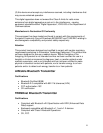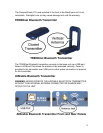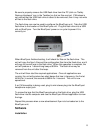1
BLUEFLYERS OVERVIEW
BlueFlyers Concept
The BlueFlyers unit electronically transmits information directly to Bluetooth
enabled cell phones, laptops, PDAs, Blackberries, or other portable devices. The
Bluetooth advertisement can contain images, audio, video, business cards, Java
applications, and more. Bluetooth marketing is proximity-based, and the choice
of Bluetooth transmitters will determine the distance covered by the marketing
effort.
The BlueFlyers unit can also transmit an FM broadcast audio message. The FM
broadcast can be used to transmit instructions on how to access BlueFlyers from
a cell phone, details about a daily special, or music. Multiple MP3 files can be put
on the BlueFlyers unit for FM transmission and the unit will rotate through them.
About Bluetooth
Bluetooth uses a wireless connection protocol that allows devices to exchange
data. This protocol is commonly built into modern cell phones and PDAs, and
many laptops. If not present, Bluetooth capability can easily be added to many of
these devices using a small external Bluetooth transmitter.
Bluetooth is in common use today in wireless headsets, allowing hands-free use
of cell phones. In addition to the voice connections, this protocol also allows the
exchange of data files. These files can be images, audio MP3s, videos, text,
Word documents, vCards (virtual business cards), or other formats.
BlueFlyers can transmit multiple file formats, including information in formats
which give the prospect immediate access to vital information and long term
access to detailed information.
Depending on the device and the format of the data transferred, the information
may be usable immediately or may need to be transferred to a PC before use.
For example, images may be viewable on cell phones and PDAs. Audio MP3s
may be playable on newer cell phones and PDAs. A Word document would not
be usable on a cell phone and would need to be transferred to a PC. Some
cellular service providers purposely cripple the cell phone manufacturer's built-in
Bluetooth functionality and limit file types that may be transferred over Bluetooth.
Using a variety of file formats helps ensure the flyer is received.
Bluetooth transfers are not "high-speed". Devices that use early versions of the
protocol are limited to a maximum of 721 kbps, while newer devices may support
up to 3 Mbps. Transferring a 1MB file to an older device could take more than 10


















